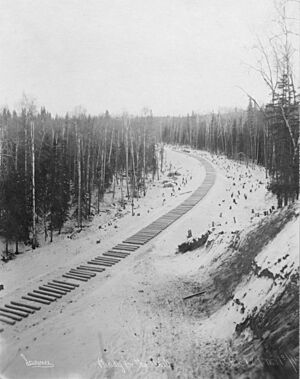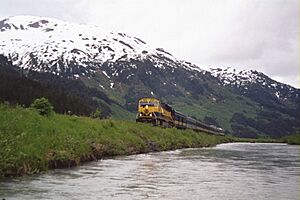Alaska Railroad facts for kids
Quick facts for kids Alaska Railroad |
|
|---|---|
 |
|
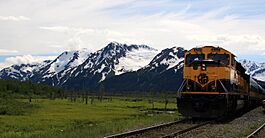
An Alaska Railroad passenger excursion train at Spencer Glacier.
|
|
| Overview | |
| Owner | State of Alaska |
| Locale | Alaska |
| Service | |
| Type | Freight and passenger railroad |
| Services | 5 |
| Daily ridership | 200 (weekdays, Q1 2023) |
| Ridership | 220,400 (2022) |
| History | |
| Commenced | 1903 |
| Purchase by US Government | March 12, 1914 |
| Completed | July 15, 1923 |
| Transfer to state | January 6, 1985 |
| Technical | |
| Line length | 470 miles (760 km) (mainline) |
| Track length | 656 miles (1,056 km) |
| Track gauge | 4 ft 8 1⁄2 in (1,435 mm) standard gauge |
| Old gauge | 3 ft (914 mm) (former Tanana Valley Railroad) |
| Signalling | Centralized traffic control or track warrant control with positive train control |
The Alaska Railroad (reporting mark ARR) is a special kind of railroad that carries both cargo (freight) and people (passengers) in the state of Alaska. Its main line stretches from Seward on the southern coast all the way to Fairbanks, which is closer to the middle of the state. Along the way, it goes through Anchorage, Alaska's biggest city, and Denali National Park. Did you know that 17% of visitors to Denali National Park arrive by train?
The railroad has about 656 miles (1,056 km) of tracks in total. This includes extra tracks for parking trains and smaller lines that branch off. The main line from Seward to Fairbanks is over 470 miles (760 km) long. There's also a branch line to Whittier. From there, freight cars can be loaded onto special barges that sail to Seattle in the lower 48 states.
The construction of this railroad began in 1903. A company called the Alaska Central Railroad started building a line from Seward. They built about 50 miles (80 km) of track before running into money problems. Another company, the Alaska Northern Railroad Company, took over in 1911 and added another 21 miles (34 km) of track. However, they also struggled financially.
Because of these difficulties, the U.S. government decided to step in. On March 12, 1914, the U.S. Congress agreed to pay for and operate a railroad that could be used all year round, connecting Seward to Fairbanks. They bought the existing rail line from the Alaska Northern Railroad.
As the government started building this big project, which was estimated to cost $35 million, they set up a construction town. This town was built along Ship Creek and eventually grew into Anchorage, which is now the largest city in Alaska. In 1917, the government also bought the Tanana Valley Railroad, mainly because it had a useful rail yard in Fairbanks. The entire railroad was finished on July 15, 1923. To celebrate, President Warren G. Harding traveled to Alaska and drove a special "golden spike" at Nenana to mark the completion. The railroad was owned by the federal government until January 6, 1985, when ownership was transferred to the state of Alaska.
In 2022, the Alaska Railroad carried 220,400 passengers. In 2019, the company made a profit of US$21.6 million.
Contents
The Story of the Alaska Railroad
Early Beginnings: Building the First Tracks
In 1903, a company called the Alaska Central Railroad started building a railway. It began in Seward, a town on the southern tip of the Kenai Peninsula. They built about 51 miles (82 km) of track by 1909. This early line helped move passengers, cargo, and mail to the upper Turnagain Arm. From there, goods were moved by boat or even by dog sleds and pack animals.
However, the Alaska Central Railroad faced financial difficulties and went out of business. In 1909, another company, the Alaska Northern Railroad Company, bought the railway. They extended the line another 21 miles (34 km) northward. But like the first company, the Alaska Northern Railroad also ran into money problems by 1914.
The U.S. Government Steps In
Around this time, the United States government had a big plan. They wanted to build a railroad route from Seward all the way to Fairbanks in the interior of Alaska. In 1912, President William Howard Taft approved a group to study the best route. The goal was to create a 656 miles (1,056 km) long railway that could be used in all kinds of weather.
In 1914, the government bought the Alaska Northern Railroad. They moved their main office to Ship Creek. This area later grew into the city of Anchorage. The government then started extending the rail line further north.
Connecting Fairbanks: The Golden Spike
In 1917, the Tanana Valley Railroad in Fairbanks was also having financial troubles. This railroad had a smaller, 45-mile (72 km) long line that served Fairbanks and nearby mining towns. It also connected to boat docks on the Tanana River.
The government bought the Tanana Valley Railroad, mainly for its important facilities in Fairbanks. They changed parts of this smaller line to match the wider tracks of the main Alaska Railroad. This helped complete the connection from Seward to Fairbanks. The Alaska Railroad continued to use some of the old narrow-gauge lines until 1930.
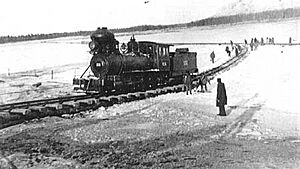
A major part of the project was building the 700-foot (213 m) Mears Memorial Bridge across the Tanana River at Nenana in 1923. This bridge was the final link for the Alaska Railroad. At the time, it was the second longest single-span steel railroad bridge in the country! U.S. President Warren G. Harding came to Alaska to drive the golden spike on July 15, 1923, marking the completion of the railroad.
Modernizing and Overcoming Challenges
The Alaska Railroad started using its first diesel locomotive in 1944. Diesel engines are more efficient than steam engines. The last steam locomotive was retired in 1966.
In 1964, a huge event affected the railroad: the Good Friday earthquake. This powerful earthquake damaged the tracks and yards around Seward and along Turnagain Arm. It took several months to fix everything and get the full service running again.
In 1985, a big change happened. The state of Alaska bought the railroad from the U.S. government for $22.3 million. The state immediately invested a lot of money to improve and repair the tracks and equipment. This helped make up for years when the railroad hadn't received enough maintenance.
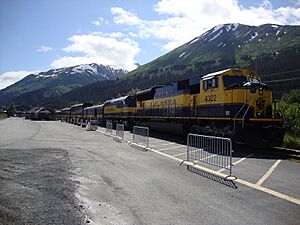
Future Plans for the Railroad
Extending North to Delta Junction
There have been ideas to extend the railroad from Fairbanks to Delta Junction. This would involve building a bridge over the Tanana River. In 2011, the state of Alaska provided $40 million for this bridge. The U.S. Department of Defense also contributed $100 million. This is because the bridge and a future rail line would provide year-round access to Fort Greely, an important military base. The bridge was opened for military road traffic in 2014.
New Line to Point MacKenzie
In 2011, a plan was approved to build a new 25 miles (40 km) rail line. This line would connect Port MacKenzie to the existing main line near Houston, Alaska. As of May 2023, this new line has not yet been completed.
Better Service in Anchorage
A short rail line was built to Ted Stevens International Airport in 2003. It even has a special station. While this line doesn't have regular scheduled service, cruise companies often use it to transport passengers between their ships and the airport. The railroad also rents out the station for events like conferences.
There are also plans to offer commuter train service within the Anchorage metropolitan area. This would help people travel between Anchorage and the Mat-Su Valley. To make this happen, more tracks would need to be built to handle both passenger and freight trains.
Connecting to the Lower 48 States
For many years, people have thought about building a rail link between Alaska and the rest of North America through Canada. In 2001, a U.S. senator from Alaska suggested forming a group to study if this was possible.
A report in 2006 suggested a hub in Carmacks, Yukon, Canada. From there, lines could go to Delta Junction, Alaska (the northern end of the Alaska Railroad). Other lines could connect to existing Canadian railways.
More recently, the idea of the Alaska Canada Rail Link (ACRL) has been discussed again. In 2015, there was talk of a route from Delta Junction, through Carmacks, and then south through British Columbia to Alberta, ending at Fort McMurray. This route was supported by the Assembly of First Nations, a group representing Indigenous peoples in Canada.
In 2020, then-President Donald Trump approved a permit for the Alaska-Alberta Railway Development Corporation (A2A Railway). This company planned to connect to the Alaska Railroad at North Pole, Alaska, and run through Yukon to Fort McMurray, Alberta. This project aimed to create a major rail connection between Alaska and Canada.
Leaders of the Railroad
General Managers Under Federal Ownership
- Col. Frederick Mears, 1919-1923
- Col. James Gordon Steese, 1923
- Lee H. Landis, 1923–1924
- Noel W. Smith, 1924–1928
- Col. Otto F. Ohlson, 1928–1945
- Col. John P. Johnson, 1946–1953
- Frank E. Kalbaugh, 1953–1955
- Reginald N. Whitman, 1955–1956
- John H. Lloyd, 1956–1958
- Robert H. Anderson, 1958–1960
- Donald J. Smith, 1960–1962
- John E. Manley, 1962–1971
- Walker S. Johnston, 1971-1975
- William L. Dorcy, 1975–1979
- Steven R. Ditmeyer (Acting) 1979-1980
- Frank H. Jones, 1980–1985
Presidents Under State Ownership
- Frank Turpin, 1985-1991
- Robert Hatfield Jr., 1991–1997
- Bill Sheffield, 1997–2001
- Patrick K. Gamble, 2001–2010
- Christopher Aadnesen, 2010–2013
- Bill O'Leary, 2013–present
Routes and Fun for Tourists
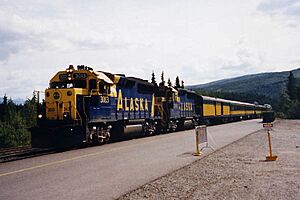
The Alaska Railroad is a very popular attraction for tourists, especially in the summer. Their passenger cars have large windows and even dome cars, offering amazing views of Alaska's scenery. Many cruise companies also use the railroad, with their own special cars pulled by Alaska Railroad engines. Train trips are often part of various cruise vacation packages.
Popular Routes for Passengers
- The Denali Star travels from Anchorage to Fairbanks. This trip takes about 12 hours one way. It stops in towns like Talkeetna and at Denali National Park. You can find many flight and bus tours from Denali National Park. The Denali Star runs only from May 15 to September 15. Even though the trip is about 356 miles (573 km), it takes 12 hours because the tracks wind through mountains and valleys. The train's top speed is 59 miles per hour (95 km/h), but it often goes closer to 30 miles per hour (48 km/h).
- The Aurora Winter Train runs during the colder months, from September 15 to May 15. It has a reduced schedule, usually on weekends, between Anchorage and Fairbanks. It follows the same route as the Denali Star.
- The Coastal Classic heads south from Anchorage along Turnagain Arm. It then turns south into the Kenai Peninsula, finally reaching Seward. This 114-mile (183 km) trip takes about four and a half hours. It's a slower journey because the line winds through mountains.
- The Glacier Discovery offers a shorter, two-hour trip south from Anchorage to Whittier. After a brief stop, it reverses direction and stops at Grandview before returning to Anchorage in the evening.
- The Hurricane Turn provides a unique service for people living between Talkeetna and the Hurricane area. This region has no roads, so the railroad is a vital link for residents to get food and supplies. It's one of the last "flag-stop" railway routes in the United States. Passengers can board the Hurricane Turn anywhere along the route by simply waving a large white flag or cloth!
- A special line to the Ted Stevens Anchorage International Airport is used during the summer for cruise ship passengers. It was also used temporarily during a large convention in 2006 to help delegates travel between the airport and their hotels.
Train Cars and Engines
By 1936, the Alaska Railroad had 27 steam locomotives (train engines), 16 railcars, 40 passenger cars, and 858 freight cars.
Currently Active Trains
As of 2022[update], the Alaska Railroad has 51 locomotives, two special control cars, and one self-propelled railcar. These include:
- 28 EMD SD70MAC locomotives (12 of these have special power for passenger trains)
- 15 EMD GP40-2 locomotives
- 8 EMD GP38-2 locomotives
- 2 EMD F40PH control cab units
- 1 Colorado Railcar DMU (a train car that can move itself)
Retired Trains
Some older trains that are no longer used by the Alaska Railroad include:
- Budd Rail Diesel Car (RDC) (retired in 2009)
- EMD MP15AC (retired in 2009)
- EMD F7
- EMD FP7 (two of these were sold to another railroad in Arizona for scenic tours)
Special Steam Locomotive: ARR 557

In 2011, the Alaska Railroad got back ARR 557. This was the last steam locomotive (an engine powered by steam) that the railroad bought new, and the last one it ever used. The plan is to fix it up and use it for special trips between Anchorage and Portage.
Engine 557 was built in 1944. It originally burned coal but was changed to use oil in 1955. It ran until 1964, when it was sold. A man named Monte Holm bought it and displayed it in his museum.
After Monte Holm passed away in 2006, two brothers, Jim and Vic Jansen, bought 557 from the museum. They returned it to the Alaska Railroad with the condition that it would be restored and put back into service.
The locomotive was then sold to a non-profit group called the Engine 557 Restoration Company for a very small price. As of January 2019, volunteers have spent over 75,000 hours working to restore and overhaul this historic steam engine!
See also
 In Spanish: Ferrocarril de Alaska para niños
In Spanish: Ferrocarril de Alaska para niños
- Alaskan Engineering Commission, the government group that built the Alaska railways
- Anton Anderson Memorial Tunnel
- Transportation in North America
- White Pass and Yukon Route


